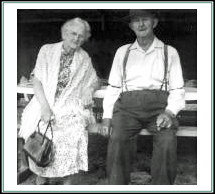|
 When August and Rika (Knaack) Heiden arrived in America, they were confronted
by an immediate personal tragedy when their infant daughter,
Meta,
died. They had left their beloved homeland and journeyed across the
ocean to an unknown land with the faith that it would lead to a
better life. Then, the first thing that happens is that they lose
one of their three children. In their grief, it appears that the
immigrant couple turned to the church for comfort. Meta was buried
in the Zion Lutheran Church cemetery in Monroe only 12 days after
their ship had arrived in the harbor at New York City. When August and Rika (Knaack) Heiden arrived in America, they were confronted
by an immediate personal tragedy when their infant daughter,
Meta,
died. They had left their beloved homeland and journeyed across the
ocean to an unknown land with the faith that it would lead to a
better life. Then, the first thing that happens is that they lose
one of their three children. In their grief, it appears that the
immigrant couple turned to the church for comfort. Meta was buried
in the Zion Lutheran Church cemetery in Monroe only 12 days after
their ship had arrived in the harbor at New York City.
August and his family settled in
Raisinville Township on a farm on
South Custer Road. They started attending the recently formed St Matthew Evangelical Lutheran Church. At the time of their arrival in
1873, the young congregation did not have a church of its own and
was still meeting at the Bridge School. In September, 1879, the new
church building on Ida-Maybee Road was officially dedicated.
 The
entire Heiden family attended that church and August’s children who
were born in America were all baptized and confirmed at St Matthew.
As a young boy, William Carl Heiden took his catechism lessons in
what was then called, “German school.” Many decades later, he could
still recite passages of his catechism in German when
Pastor Thomas
came to visit. All of his children were also baptized and confirmed
from the little white church on Ida-Maybee Road. Several of them
were married there and some of his children and grandchildren are
buried in the church cemetery. The
entire Heiden family attended that church and August’s children who
were born in America were all baptized and confirmed at St Matthew.
As a young boy, William Carl Heiden took his catechism lessons in
what was then called, “German school.” Many decades later, he could
still recite passages of his catechism in German when
Pastor Thomas
came to visit. All of his children were also baptized and confirmed
from the little white church on Ida-Maybee Road. Several of them
were married there and some of his children and grandchildren are
buried in the church cemetery.
Mary Rambow was a member of the church too. Her family also carried
a deep dedication to the Lutheran religion. Family members recount
how, in the Rambow house, it was a nightly ritual
to read a passage
from the Bible aloud in German before retiring to bed.
 Among the cherished memories of many of the children and
grandchildren of William Carl and Mary (Rambow) Heiden are the wonderful Christmas
Eve gatherings. It was the custom for many years for everyone to
attend the church service which included a program presented by the
children of the congregation. Many of the Heidens remember having to
recite verses or to participate in a reenactment of the manger
scene. Christmas carols would echo through the tiny church and into
the connecting hall as the congregation celebrated the Christmas
spirit. Among the cherished memories of many of the children and
grandchildren of William Carl and Mary (Rambow) Heiden are the wonderful Christmas
Eve gatherings. It was the custom for many years for everyone to
attend the church service which included a program presented by the
children of the congregation. Many of the Heidens remember having to
recite verses or to participate in a reenactment of the manger
scene. Christmas carols would echo through the tiny church and into
the connecting hall as the congregation celebrated the Christmas
spirit.
After the service, everyone would go to “Grandpa and Grandma’s”
house on Dixon Road. The house would be so crowded that Grandpa
feared that the floor might buckle. Children were everywhere and
there was plenty of good food. Each family gave a gift to the
grandparents and the children received a present from each of their
godparents.
 The
name of this church is often mistaken as St Matthew's
but is, in reality, St Matthew. The
name of this church is often mistaken as St Matthew's
but is, in reality, St Matthew.
|

